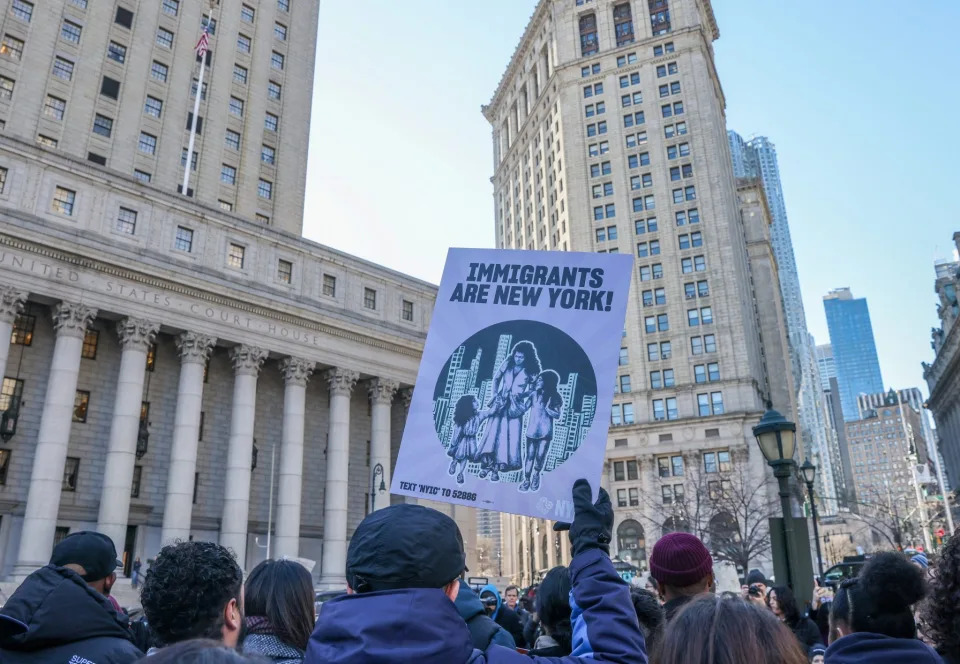Irina Ivanova
Tue, February 6, 2024

Selcuk Acar—Anadolu/Getty Images
A major economic mystery of the post-pandemic U.S. is how, with the tightest labor market in decades, employers keep adding jobs every month—even as record-high inflation steadily cools.
To that question, Nobel Prize–winning economist Paul Krugman has a simple answer: It’s the immigration, stupid.
“The economy is chugging along, creating lots of jobs, inflation is basically in the rearview mirror now, and not a hint of all of the terrible stuff that was supposed to be happening,” Krugman told the New Republic’s Daily Blast podcast on Sunday.
A major reason that employers have been able to keep hiring without refueling inflation is because the labor force is growing, Krugman noted.
“How much of the increase in the labor force is foreign-born workers? How much of the increase since 2020 is foreign workers? The answer is all,” he said, adding that every aspect of U.S. outperformance relative to other advanced countries is due to its ability to grow rapidly, thanks to the availability of foreign-born workers.
Immigration to the U.S. dipped slightly at the start of the Trump administration before plummeting in 2020 amid COVID-induced lockdowns, then rebounded two years later. That’s been reflected in the labor force data: As of this month, there were 3.1 million more immigrant workers in the labor force than just before the pandemic. Meanwhile, the native-born labor force rose to 1.5 million above its pandemic level last summer, but has since shrunk to below those levels.
View this interactive chart on Fortune.com
“The aftermath of the pandemic-era shutdowns of immigration was one of the tightest labor markets we’ve ever seen, and it started to cool as labor became more available,” Aaron Terrazas, chief economist at Glassdoor, told Fortune. “Correlation isn’t causation, of course, but it’s a natural way to think about it.”
That’s a big deal for the Federal Reserve because the Fed has been laser-focused on the job market as it decides where to take interest rates—even though workers’ raises are only partly responsible for the pandemic inflation surge.
“The economy is not only continuing to grow but it seems to be accelerating; inflation has fallen from about 9% to nearly 2% again. A big part of that is the big rebound we’ve seen in the labor force and productivity growth,” said Andrew Hunter, deputy chief U.S. economist at Capital Economics, who also point to the increased labor-force participation of women, and mothers in particular, as a surprise factor. “That’s helped to keep growth strong and also keep inflation down. That’s something not many people were predicting.”
But doesn’t the addition of 3 million foreign-born workers mean that those jobs aren’t going to American-born workers? Well, no, Krugman says.
“They're not stealing American jobs,” he said on Daily Blast.
Foreign-born workers tend to have different skills and work in different industries, and so “they're not perfect substitutes for American workers," Krugman added. "What they do is they open up space to run the economy hotter, and almost certainly actually lead to higher employment among people born here."
Here’s one example of how that might work. Immigrants are heavily represented in the care sector, as nannies, au pairs, home health aides, and nursing-home assistants. By caring for middle- and upper-class Americans’ children and homes (at a fairly low cost), immigrants allow middle-class women to do more paid work in the workforce.
In fact, immigration has helped narrow the gender pay gap in high-powered industries without requiring a drop in birth rates among middle-class native-born women, according to a National Bureau of Economic Research working paper by Patricia Cortés. Immigration also makes it easier for people to age in place by lowering the costs of home health care and landscaping, a different NBER paper found.
View this interactive chart on Fortune.com
“That’s a market intervention that makes those services available for middle-class and upper-earning households, but [it creates] competition for people providing services as well,” said Terrazas. Other examples include the lower-paid ranks of health care, as well as agriculture, where low prices for food are made possible by the backbreaking work and low pay of thousands of immigrants and temporary foreign workers.
“We don’t have one immigration policy; we have different policies at different skill levels,” Terrazas added. Choosing the “right” amount of immigration necessarily means balancing different constituencies, and making deliberate choices about which industries should prioritize higher worker pay and which should focus on lower end-user prices, he said.
Of course, immigrants aren’t only workers, but “people with lives and families,” Terrazas said. “Immigrants are also consumers; they have kids, and families, and they go to school and use roads and parks and recreational facilities.”
This consumer demand is another force driving the economy forward, by creating demand for goods and services. And immigrants tend to start businesses at higher rates than native-born Americans, including businesses that then employ other people. Krugman illustrated this with an example from his childhood home of Utica, where a Bosnian refugee started the now-thriving Chobani Yogurt company. (“It's actually Bosnian yogurt,” Krugman quipped.)
“It turns out that the dynamism, the vitality of the U.S. economy is very much aided by the inflow of immigrants,” he said.
None of that means we should be advocating for fully open borders, Krugman made pains to note. But it suggests that the U.S. economy has a long way yet to go before the supply of workers becomes too much to handle.
As Apollo chief economist Torsten Slok wrote recently, the native-born workforce in the U.S. still has about 5 million “missing workers”—including people who died during the pandemic—as well as the missing growth after it.
“These 5 million missing workers are the reason why the labor market is tight and why wage inflation is likely to remain elevated,” Slok wrote. “Put differently, there is still plenty of room for job growth.”
This story was originally featured on Fortune.com
No comments:
Post a Comment